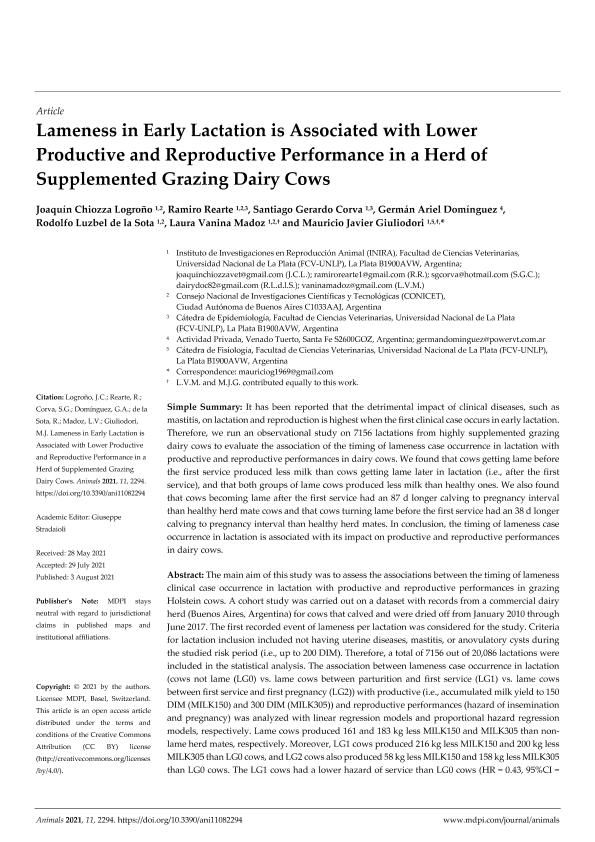Artículo
Lameness in early lactation is associated with lower productive and reproductive performance in a herd of supplemented grazing dairy cows
Chiozza Logroño, Joaquin ; Rearte, Ramiro
; Rearte, Ramiro ; Corva, Santiago Gerardo; Domínguez, Germán Ariel; de la Sota, Rodolfo Luzbel
; Corva, Santiago Gerardo; Domínguez, Germán Ariel; de la Sota, Rodolfo Luzbel ; Madoz, Laura Vanina
; Madoz, Laura Vanina ; Giuliodori, Mauricio Javier
; Giuliodori, Mauricio Javier
 ; Rearte, Ramiro
; Rearte, Ramiro ; Corva, Santiago Gerardo; Domínguez, Germán Ariel; de la Sota, Rodolfo Luzbel
; Corva, Santiago Gerardo; Domínguez, Germán Ariel; de la Sota, Rodolfo Luzbel ; Madoz, Laura Vanina
; Madoz, Laura Vanina ; Giuliodori, Mauricio Javier
; Giuliodori, Mauricio Javier
Fecha de publicación:
08/2021
Editorial:
Multidisciplinary Digital Publishing Institute
Revista:
Animals
ISSN:
2076-2615
Idioma:
Inglés
Tipo de recurso:
Artículo publicado
Clasificación temática:
Resumen
The main aim of this study was to assess the associations between the timing of lameness clinical case occurrence in lactation with productive and reproductive performances in grazing Holstein cows. A cohort study was carried out on a dataset with records from a commercial dairy herd (Buenos Aires, Argentina) for cows that calved and were dried off from January 2010 through June 2017. The first recorded event of lameness per lactation was considered for the study. Criteria for lactation inclusion included not having uterine diseases, mastitis, or anovulatory cysts during the studied risk period (i.e., up to 200 DIM). Therefore, a total of 7156 out of 20,086 lactations were included in the statistical analysis. The association between lameness case occurrence in lactation (cows not lame (LG0) vs. lame cows between parturition and first service (LG1) vs. lame cows between first service and first pregnancy (LG2)) with productive (i.e., accumulated milk yield to 150 DIM (MILK150) and 300 DIM (MILK305)) and reproductive performances (hazard of insemination and pregnancy) was analyzed with linear regression models and proportional hazard regression models, respectively. Lame cows produced 161 and 183 kg less MILK150 and MILK305 than non-lame herd mates, respectively. Moreover, LG1 cows produced 216 kg less MILK150 and 200 kg less MILK305 than LG0 cows, and LG2 cows also produced 58 kg less MILK150 and 158 kg less MILK305 than LG0 cows. The LG1 cows had a lower hazard of service than LG0 cows (HR = 0.43, 95%CI = 0.39–0.47). Furthermore, LG1 cows had a lower hazard of pregnancy than LG0 cows (HR = 0.52, 95%CI = 0.46–0.59) and took longer to get pregnant than LG0 cows (median [95%CI], 139 [132–144] vs. 101 [99–103]). Moreover, LG2 cows had a much lower hazard of pregnancy than LG0 cows (HR = 0.08, 95%CI = 0.05–0.12) and much longer calving to first pregnancy interval than LG0 cows (188 [183–196] vs. 101 [99–103]). In conclusion, cows that become lame in early lactation produce less milk and have lower hazards of insemination and pregnancy than herd mates that are healthy or become lame later in lactation. In addition, cows that become lame immediately after the voluntarily waiting period have the poorest reproductive performance (i.e., they have the lowest hazard of pregnancy and the longest calving to pregnancy interval).
Palabras clave:
CLINICAL LAMENESS
,
GRAZING DAIRY COW
,
MILK YIELD
,
REPRODUCTIVE PERFORMANCE
Archivos asociados
Licencia
Identificadores
Colecciones
Articulos(CCT - LA PLATA)
Articulos de CTRO.CIENTIFICO TECNOL.CONICET - LA PLATA
Articulos de CTRO.CIENTIFICO TECNOL.CONICET - LA PLATA
Citación
Chiozza Logroño, Joaquin; Rearte, Ramiro; Corva, Santiago Gerardo; Domínguez, Germán Ariel; de la Sota, Rodolfo Luzbel; et al.; Lameness in early lactation is associated with lower productive and reproductive performance in a herd of supplemented grazing dairy cows; Multidisciplinary Digital Publishing Institute; Animals; 11; 8; 8-2021; 1-10
Compartir
Altmétricas



